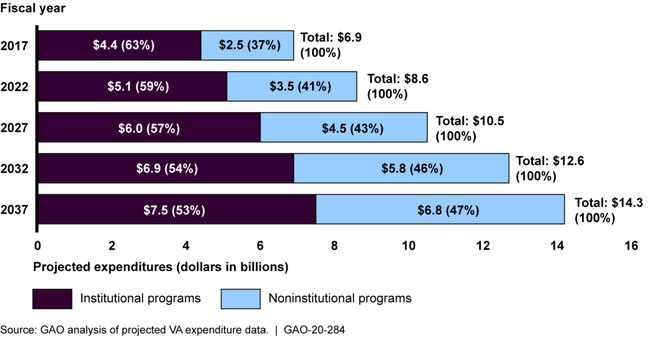
VA and DOD Patient Care
Both VA and DOD need to improve their ability to provide timely, high-quality health care to veterans and servicemembers.
There have been numerous reports of the Department of Veterans Affairs’ (VA) medical facilities failing to provide timely and accessible care—and in some cases, delays in care or failure to provide care reportedly resulted in harm to veterans. There have also been concerns about the Department of Defense’s (DOD) ability to provide care to servicemembers.
Both VA and DOD need to improve the access to and quality of their health care programs—particularly access to health care in department medical facilities and VA's community care program, and the quality and safety of patient care provided at VA medical facilities.
Access to health care
The VA has faced a growing demand for outpatient primary care services over the past decade. However, not all veterans have been able to access primary care within VA. Moreover, the veterans who were able to receive care experienced wide variation in the amount of time they waited for primary and specialty care. To ensure that veterans have timely access to medical appointments, VA needs to make sure that its data on veterans’ wait times is reliable. VA is also having difficulty meeting the growing demand for long-term care for veterans in nursing homes and veterans’ homes due to workforce shortages, geographic alignment of care, and specialty care needs.
VA Projections for Long-Term Care Expenditures, FYs 2017-2037

Note: These long-term care programs include those VA projects using its Enrollee Health Care Projection Model. This model includes 12 of VA’s 14 Long-Term Services and Supports programs, excluding State Veterans Homes and State Home Adult Day Health Care.
Additionally, DOD offers health care services to over 9 million people through its TRICARE program. The National Defense Authorization Act of 2017 made several changes to TRICARE, including establishing a new preferred provider network option called TRICARE Select. The act also required DOD to develop an implementation plan for TRICARE Select that addresses specific issues, such as access to care and beneficiary complaints. While DOD's implementation plan addressed all required issues, it doesn't reflect DOD's current approach for establishing access standards. DOD should provide written documentation of its current approach to Congress.
VA's Community Care Program
The VA implemented the Veterans Community Care Program (VCCP) in June 2019—replacing similar programs that allow eligible veterans to receive care from non-VA providers. However, there are a number of issues with how VA has implemented this program.
For instance:
- VA hasn't established a timeliness goal for veterans to receive care in the community.
- Few community providers use the VA's new software system to exchange information electronically with VA medical centers.
- Few VA medical centers have the recommended number of staff to operate their community care programs.
- The metrics VA used to determine if the VCCP scheduling process is working appropriately are not aligned with the established VCCP scheduling timeframes.
- VA needs to monitor female veterans’ access to sex-specific care in the community, such as mammograms.
Potential Allowable Wait Time to Obtain Care through the Veterans Community Care Program

Note: This figure illustrates potential allowable wait times in calendar days for eligible veterans who are referred to the VCCP through routine referrals (non-emergent), and have VA medical center staff—RCT and community care staff (CC staff)—schedule the appointments on their behalf.
Quality of care and patient safety at VA
Preventing veteran suicide is the VA’s highest clinical priority. The VA started tracking suicide deaths on VA campuses in 2017, but this data had errors. The VA also isn't fully using its data to analyze veteran suicides. VA should improve how it tracks and analyzes this data to better address and prevent on-campus veteran suicides.
Additionally, the VA requires its medical centers to review a doctor’s care if quality or safety concerns arise. If VA medical center officials decide a doctor should no longer provide care to veterans, they are required to inform hospitals and other health care entities by reporting to a national database and to the states where the doctor is licensed. However, these reviews are not always timely, and VA officials did not regularly report doctors who should have been reported.
Finally, VA researchers have found that LGBT veterans may experience higher rates of depression and more frequent thoughts of suicide. However, the VA can't systematically analyze the health of these veterans because it doesn't consistently collect data on sexual orientation or self-identified gender identity.





